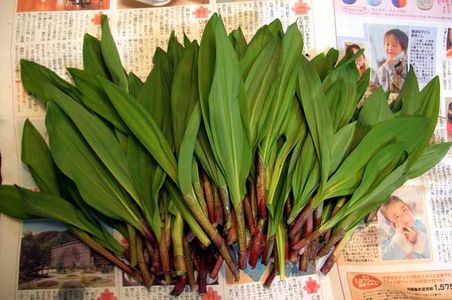Allium victorialis
Allium victorialis L.
| Order | Asparagales |
|---|---|
| Family | Amaryllidaceae |
| Genus | Allium |
2n =
Origin : Eurasia
wild or cultivated
| English | Alpine leek |
|---|---|
| French | ail de la Sainte-Victoire |
- leaves and floral stems edible
- medicinal
- magical
Description
- herbaceous perrenial plant 30-60 cm high, glabrous
- oblong bulb covered by a fibrous reticulate tunic
- thick scape, with leaves up to the middle
- leaves 3-5 cm broad, elliptic-lanceolate, shortly petioled, flat
- spathe univalve, oval, shorter than the umbel
- flowers greenish white becoming yellowish, in a globose many-flowered tight umbel without bulbils
- pedicels equal, longer than the flower
- perianth bell-like, with oblong erected divisions
- exerted stamens, all with simple filaments
- yellow anthers
- naked, globose capsule with three angles
Popular names
| anglais | Alpine leek, victory onion |
| français | ail de la Sainte-Victoire, ail de cerf |
| allemand | Siegwurz, Allermannsharnisch |
| russe | черемша - čeremša |
| japonais | 行者ニンニク - gyoujya-ninniku, ヒトビロ - hitobiro, - アイヌねぎ ainu-negi |
- See the etymology of victorialis
Classification
Allium victorialis L. (1753)
Linné wrote Victorialis, with a capital, which shows that he considered the word as a substantive. This is why the epithet doen't agree withe the neuter gender of Allium.
Cultivars
History
| De Victoriali longa vulgo nuncupata. Nascitur copiose in scopulis Durrestein, duobus supra Gamingam miliaribus, & montanis pastoribus Lanlauch dicitur, quibus magno in usu est adversus corrupti aëris & nebularum exhalationes. Invenitur & in montibus qui Bohemiam à Silesia disterminant, ubi Siegwurtz à Germanis appellatur, quoniam qui effodiendis metallis operam dant, magnas certasque illius facultates se experiri prædicant, ad muniendum sese adversus impurorum spirituum insultus, à quibus frequentissimè impetuntur : unde etiam Victorialis nomen ab effectu inditum contendunt. Matthiolus Allium anguinum vocavit.
____________________ It grows abundantly in the rocks of Durrestein, at two milliar stones above Gamingam, and is called Lanlauch by the mountain shepherds, who make a great use of it against corrupted air and cloud exhalations. It can also be found in the mountains separating Bohemia from Silesia, where it is called Siegwurtz by the Germans, because those working to extract metals affirm tha they experienced its great and certain faculties to protect themselves against the assaults of impure spirits which attack them very frequently: and this is why they affirm that it was given the name Victorialis. NB. : Victorialis rotunda is a Gladiolus. Clusius, Carolus, 1583. Rariorum aliquot stirpium, 224-226
|
| Die siegwurtz wird also genent / dieweil die Bergknappen sich derselbigen gebrauchen / die Gespenst und böse Geister darmit zu vertreiben / von welchen sie sehr angesochten werden.
____________________ Siegwurtz is so called / because miners in mountains use it / to frighten ghosts and evil spirits / which assault them a lot. Tabernaemontanus, 1588. New Kreuterbuch. Frankfurt/Main, 875
|
| Zu Zeiten des Dreißigjährigen Krieges wurde der Allermannsharnisch (wörtlich: ein Harnisch für jedermann) als Schutzmittel gegen Verwundungen emfohlen, wie Grimmelshausen in seinem Werk Der Abentheuerliche Simplicissimus Teutsch berichtet, als der Protagonist als vermeintlicher Schweizer Arzt durch die Lande zieht:
Sorgt aber nit ! ´s braucht´r nix als diese Wurzel oder Kraut, den Allermannsharnisch. [...] geht auch kein Dega oder Kugel durch Euern Leib, wenn Ihr hinter einer alten Wand oder Mauer steht. Hab´s selbst probiert und dies einzige Stück ist das doppelt Geld wert. ____________________ During the thirty years war, Allermannsharnisch (litt. armour for everybody) was used as a protection against wounds, as Grimmelshausen writes in Der Abentheuerliche Simplicissimus Teutsch (The Simplicissimus Adventurous German), when the protagonist travels in the country as a presumed Swiss doctor : Don't worry! You need nothing else tahn this root or plant, the Allermannsharnisch. No spade, no bullet will transperce your body, if it is behind an old wall. I tried it myself and only one bit is worth twice its money. Grimmelshausen, 1668. Der Abentheuerliche Simplicissimus Teutsch
|
| The roots was considered by the Bohemian miners, when worn as an amulet, to be a safeguard against the attacks of certain impure spirits, to which they deemed themselves exposed.
Curtis's Botanical Magazine, 1809. 30: 1222.
|
The plant is sometimes cultivated in the mountainous regions of Caucasus.
Uses
The bulb has been used as an amulet. It was supposed to protect soldiers from wounds and miners frome evil spirits, due to its fibrous tunic.
References
- Marzell, Heinrich, 1927. Allermannsharnisch. In: Handwörterbuch des deutschen Aberglaubens, tome 1, 266.
- Schöpf, Hans, 1986. Zauberkräuter. Graz, Akademische Druck- und Verlagsanstalt. 175 p.








